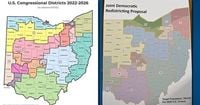Ohio’s latest congressional redistricting battle is heating up as lawmakers missed their first key deadline, thrusting the process into a new phase that could shape the state’s—and the nation’s—political landscape for years to come. On October 5, 2025, Ohio legislators failed to reach a bipartisan agreement or hold a decisive vote on a new congressional map, a setback that underscores the high-stakes, deeply partisan fight over how political power is distributed in the Buckeye State.
According to WBNS-10 TV, the Ohio Redistricting Commission must now reconvene with an October 31 deadline looming. If the commission fails to produce a map by then, the responsibility will revert to lawmakers, who have until November 30 to pass a plan, this time requiring only a simple majority rather than the 60% threshold initially mandated by the state constitution.
The urgency and tension were palpable during the Joint Redistricting Committee’s second meeting of the year on October 1, where lawmakers and citizens alike packed in nearly three hours of testimony. The focus? A proposed map from state Democrats that, while still favoring Republicans, would reduce their advantage from 10 seats to eight. The Republican Party, for its part, has yet to submit its own map—an omission that drew pointed criticism from both the public and Democratic lawmakers.
“The word fairness is not in the Constitution, correct?” Senator Jane Timken (R-Canton) pressed Senate Minority Leader Nickie Antonio (D-Lakewood), as reported by WBNS-10 TV. Antonio shot back, “I think it’s pretty difficult to talk about drawing congressional districts and your representative and your voice without talking about fairness.” The exchange highlighted the philosophical divide at the heart of redistricting: Is it about adhering strictly to legal language, or about ensuring voters feel their voices are truly represented?
State Representative Nick Santucci (R-Niles) illustrated the complexity of the issue by displaying two posters—one showing how Ohio’s counties voted in the 2024 election, the other dividing those counties by the party affiliation of their commissioners. “If we take the map that you and your party proposed and we draw it based on that, what do we say? Is it fair to the other folks that live in these communities that this is the map that you’ve given them?” Santucci asked. Antonio responded, “People vote. Land mass doesn’t vote. We have taken into consideration the people’s voice rather than geography.”
The public’s frustration with the process was evident throughout the hearing. Many expressed exasperation with what they saw as gerrymandering and the lack of a Republican map to move the debate forward. “There’s not a map I know of. We’re conducting hearings as we’re required to do, and that’s where we’re at right now,” said Rep. Adam Bird (R-New Richmond), candidly acknowledging the absence of a GOP proposal.
Ohio’s redistricting process has become a participatory affair, with nearly 90 maps submitted by private citizens and interest groups. Among them is Dana Miller, an Oxford resident who has devoted about 40 hours to crafting his own versions. “I’m on like the third version. I’ve spent probably 40 hours doing these maps,” Miller told WBNS-10 TV. His latest submission, made two weeks ago, still gives Republicans 10 seats, but he testified that a 9-6 split is possible—falling between the Democrats’ 8-7 proposal and the current arrangement. “You’ve got to have a balanced population in each district and keeping communities of interest together,” Miller said, though he admitted growing frustrated and skeptical about whether this round would differ from the contentious 2023 redistricting.
Ohio’s struggle is far from isolated. Across the country, redistricting has become a battleground in the broader fight for control of Congress. As the Los Angeles Times noted in a recent analysis, the stakes are especially high because of the national implications: “There’s a reason for the fearsome redistricting fight raging across America. It’s about Democrats trying to rein in Donald Trump and his rogue-elephant regime. Or, if you’re the country’s aspiring strongman, it’s about avoiding accountability and sanction.” The piece frames the redistricting battle as an existential struggle for both parties, with Republicans accused of gerrymandering to maintain their grip on the House, while Democrats seek “payback” by redrawing congressional lines in states like California through measures such as Proposition 50.
Proposition 50, in particular, has drawn attention for its attempt to overturn California’s highly regarded independent redistricting process, which was designed to keep politicians out of the map-drawing business. Some see the move as justified retaliation for Republican efforts in other states, while critics argue it undermines a system that has been hailed as a national model. The debate in California mirrors the philosophical and practical divides seen in Ohio—should redistricting be a tool for partisan advantage, or should it strive for neutrality and fair representation?
Meanwhile, the national political landscape is fraught with uncertainty. The 2026 Senate elections, with 35 seats at stake, present daunting odds for Democrats, who must gain four seats to seize control. As the Los Angeles Times reports, most of these races lean Republican, with only a handful considered competitive. Texas, long a source of Democratic hope and heartbreak, is again in the spotlight. Senator John Cornyn seeks a fifth term, facing a bruising primary against Attorney General Ken Paxton, whose scandals have made the contest unpredictable. Democrats hope to capitalize on potential GOP infighting, but as former Texas land commissioner Garry Mauro put it, “To say this isn’t a leaning-R state would be Pollyannish, and I’m not Pollyannish.”
Ohio’s redistricting drama, then, is emblematic of a larger national struggle. Whether in the Buckeye State, California, or Texas, the drawing of political maps is about more than lines on a page—it’s about who gets heard, who holds power, and whose vision for the country prevails. With deadlines fast approaching and partisan tensions running high, the outcome in Ohio could serve as a bellwether for the future of congressional representation across America.
As the state’s redistricting commission faces its October 31 deadline, all eyes will be on whether Ohio can break its cycle of gridlock and deliver a map that satisfies both the letter and the spirit of fair representation. For now, the only certainty is that the fight is far from over, and the consequences will ripple far beyond state lines.




